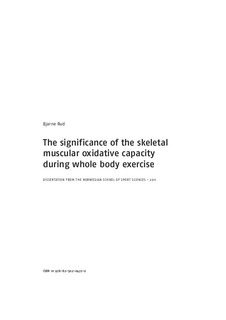| dc.contributor.author | Rud, Bjarne | |
| dc.date.accessioned | 2012-09-19T11:02:03Z | |
| dc.date.available | 2012-09-19T11:02:03Z | |
| dc.date.issued | 2011 | |
| dc.identifier | Seksjon for fysisk prestasjonsevne / Department for physical performance | |
| dc.identifier.isbn | 978-82-502-0472-0 | |
| dc.identifier.uri | http://hdl.handle.net/11250/171315 | |
| dc.description | Avhandling (doktorgrad) – Norges idrettshøgskole, 2011. | no_NO |
| dc.description.abstract | The present thesis consists of four studies with the main objective to examine the significance of the skeletal
muscular metabolic capacity during whole body exercise. Exercise capacity was studied in chronic obstructive
lung disease (COPD) patients and a control group in study I, and in endurance‐trained subjects and normal
physical active subjects in study II. In both studies, muscular metabolic capacity was quantified during exercise
with a small muscle mass (1.7‐2.8 kg) to avoid the issue of muscular oxygen uptake being limited by oxygen
supply. Thereafter, we tested how much the muscular metabolic capacity could be exploited during whole body
exercise (bicycling). Exploitation less than 100% indicated a muscular metabolic reserve probably due to oxygen
supply limitations. The muscular metabolic capacity ranged from 264 to 570 ml.kg‐1.min‐1 for the four groups.
However, there was less variation in the relative exploitation of the muscular metabolic capacity during whole
body exercise for the healthy groups (31%‐37%), while this percentage was smaller (17%) for the COPD patients.
Based on these results, we concluded that the exploitation of the muscular metabolic capacity was relatively
equal for the healthy groups despite large differences in age and maximal oxygen uptake (VO2max). The COPD
patients were least capable of exploiting the muscular metabolic capacity during bicycling and consequently,
they had a relatively higher muscular metabolic reserve during whole body exercise compared with healthy
subjects. | no_NO |
| dc.description.abstract | Paper I: Rud B, Christensen CC, Ryg M, Edvardsen A, Skumlien S, & Hallen J (2008). Higher skeletal
muscular metabolic reserve capacity in COPD patients than healthy subjects. Scand J Med Sci
Sports. | |
| dc.description.abstract | Paper II: Tatt ut av filen i Brage p.g.a. copyright-restriksjoner. / Not in the file in Brage because of copyright issues. | |
| dc.description.abstract | Paper III: B. Rud, Ø. Foss, P. Krustrup, N.H. Secher and J. Hallén. One‐legged endurance training: leg
blood flow and oxygen extraction during cycling exercise (Paper in revision). | |
| dc.description.abstract | Paper IV: B. Rud, N. H. Secher, J. Nilsson, G. Smith, and J. Hallén. Metabolic balance between the arms
and the legs during simulated skiing (Paper in preparation). | |
| dc.language.iso | eng | no_NO |
| dc.subject | maksimalt oksygenopptak | no_NO |
| dc.subject | skjelettmuskulatur | no_NO |
| dc.subject | kapasitet | no_NO |
| dc.subject | trening | no_NO |
| dc.subject | utholdenhet | no_NO |
| dc.subject | lungesykdommer | no_NO |
| dc.subject | skisport | no_NO |
| dc.subject | sykling | no_NO |
| dc.title | The significance of the skeletal muscular oxidative capacity during whole body exercise | no_NO |
| dc.type | Doctoral thesis | no_NO |
| dc.subject.nsi | VDP::Mathematics and natural science: 400::Basic biosciences: 470 | no_NO |
| dc.subject.nsi | VDP::Social science: 200::Social science in sports: 330::Other subjects within physical education: 339 | no_NO |
